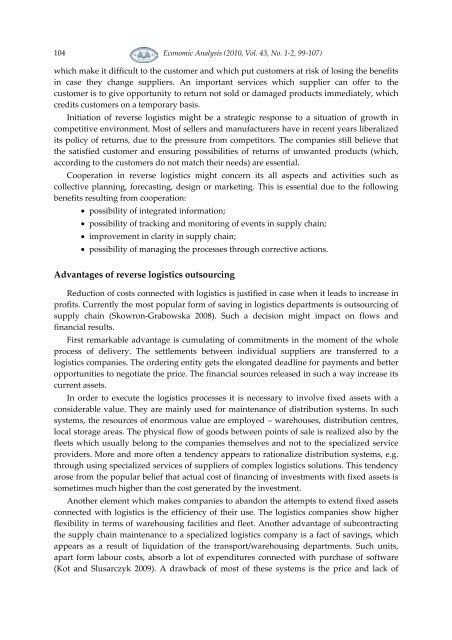Twice a Year Scientific Journal
Twice a Year Scientific Journal
Twice a Year Scientific Journal
You also want an ePaper? Increase the reach of your titles
YUMPU automatically turns print PDFs into web optimized ePapers that Google loves.
104<br />
Economic Analysis (2010, Vol. 43, No. 1-2, 99-107)<br />
which make it difficult to the customer and which put customers at risk of losing the benefits<br />
in case they change suppliers. An important services which supplier can offer to the<br />
customer is to give opportunity to return not sold or damaged products immediately, which<br />
credits customers on a temporary basis.<br />
Initiation of reverse logistics might be a strategic response to a situation of growth in<br />
competitive environment. Most of sellers and manufacturers have in recent years liberalized<br />
its policy of returns, due to the pressure from competitors. The companies still believe that<br />
the satisfied customer and ensuring possibilities of returns of unwanted products (which,<br />
according to the customers do not match their needs) are essential.<br />
Cooperation in reverse logistics might concern its all aspects and activities such as<br />
collective planning, forecasting, design or marketing. This is essential due to the following<br />
benefits resulting from cooperation:<br />
• possibility of integrated information;<br />
• possibility of tracking and monitoring of events in supply chain;<br />
• improvement in clarity in supply chain;<br />
• possibility of managing the processes through corrective actions.<br />
Advantages of reverse logistics outsourcing<br />
Reduction of costs connected with logistics is justified in case when it leads to increase in<br />
profits. Currently the most popular form of saving in logistics departments is outsourcing of<br />
supply chain (Skowron-Grabowska 2008). Such a decision might impact on flows and<br />
financial results.<br />
First remarkable advantage is cumulating of commitments in the moment of the whole<br />
process of delivery. The settlements between individual suppliers are transferred to a<br />
logistics companies. The ordering entity gets the elongated deadline for payments and better<br />
opportunities to negotiate the price. The financial sources released in such a way increase its<br />
current assets.<br />
In order to execute the logistics processes it is necessary to involve fixed assets with a<br />
considerable value. They are mainly used for maintenance of distribution systems. In such<br />
systems, the resources of enormous value are employed – warehouses, distribution centres,<br />
local storage areas. The physical flow of goods between points of sale is realized also by the<br />
fleets which usually belong to the companies themselves and not to the specialized service<br />
providers. More and more often a tendency appears to rationalize distribution systems, e.g.<br />
through using specialized services of suppliers of complex logistics solutions. This tendency<br />
arose from the popular belief that actual cost of financing of investments with fixed assets is<br />
sometimes much higher than the cost generated by the investment.<br />
Another element which makes companies to abandon the attempts to extend fixed assets<br />
connected with logistics is the efficiency of their use. The logistics companies show higher<br />
flexibility in terms of warehousing facilities and fleet. Another advantage of subcontracting<br />
the supply chain maintenance to a specialized logistics company is a fact of savings, which<br />
appears as a result of liquidation of the transport/warehousing departments. Such units,<br />
apart form labour costs, absorb a lot of expenditures connected with purchase of software<br />
(Kot and Slusarczyk 2009). A drawback of most of these systems is the price and lack of
















